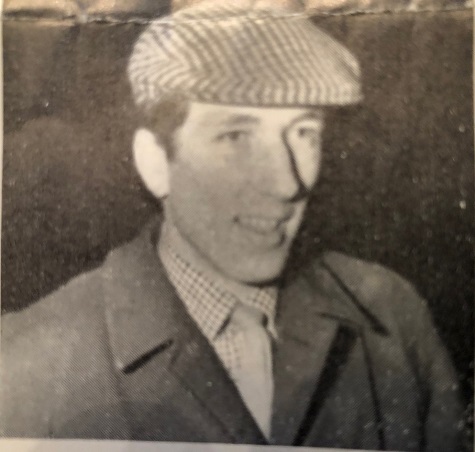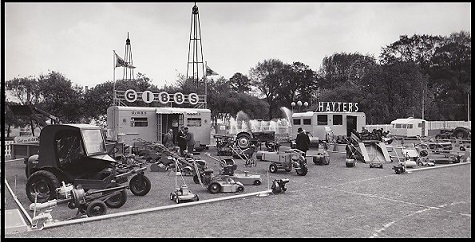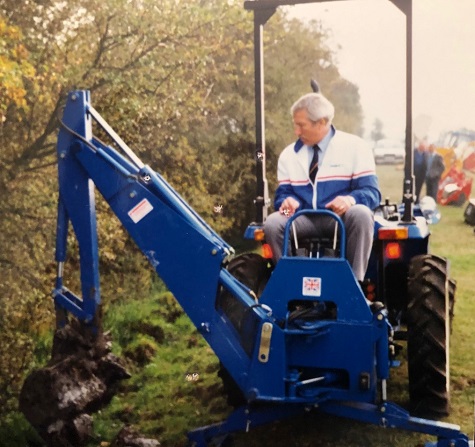
Being closer to the end of my career than the beginning, I can look back and assess the changes that had occurred in the two markets that I have been involved in, namely agriculture and grounds care - both are incestuous in that people rarely leave for pastures new or migrate from one to the other.
Being brought up in a rural environment in North Nottinghamshire it was a choice of working on a farm or going ‘down the pit’. The latter didn’t have much attraction for me, I wanted to drive a tractor. Being a member of the Young Farmers Club and getting a job with an agricultural cooperative in the contracting department, I eventually got to drive one, This led me, by way of driving a lorry delivering potatoes and produce to wholesale markets nationwide and assistant manager of the potato and produce plant, to becoming a salesman on the road. In my Ford Popular, 3 speed box, with no heater or radio, oh boy I felt I’d made it!
I was given a box of leaflets and a list of names and addresses, a pat on the back and an “off you go”. The ag market in those days, where the average size farm was about 200 acres and mainly family farms at that, was relatively buoyant. It was my start. Like a lot of people, I thought it would be easy. Well I guess in my naivety it was, but it depends on where you set your targets and ambitions. I set mine high. I may get there one day. You never know.
After several sales courses, the most instructive of which were at the Ford school in Boreham and several Peter Veevers type by various organisations, I learned the art of the “salesman”. Features, advantages, and benefits – or FABs. Ask questions, listen, assess, present, make eye contact, ask for the order. Lots of deals were done round the kitchen table on a handshake or in the pub on an evening at Young Farmers, NFU do’s and the like.
My first venture nationally was an eye opener in that I now had to visit the dealer network as well as accompanying dealer salesman, doing sales presentations, shows, and managing my time and persuading all and sundry that our franchise should be put first and foremost.
We went through the plough-less farming bit without too much of a hiccup and with big financial institutions getting interested in buying up land as an investment, farms became bigger and so did tractors and equipment. I was often referred to in those day by a lot of my client base as the “most expensive man on the planet”. This is where I noticed the first big change in buying trends, The big estates had always had farm managers but now some of the larger units had them and budgets and quotes came into it. The major manufacturers expressed interest in these as well and wanted input into what went on, tying up a deal for 50 tractors at a time on some big units.

Poggy in his younger days
Today a lot of people say, “Ah, you had it easy in those days”, but it all depends on where you set your targets. We didn’t do ‘quotes’ or demos, we ‘sold’ the product – FABs . . .
Roadshows, demo days, County shows, National Shows, International Shows, long hours were spent following up leads from these events. No mobile phones remember, it was done from home on the phone, from hotels, even letters (remember them?!).
It was about this time I got my first credit card for the phone. If you could find a phone box that worked, my word, what a leap! Pagers followed much later though.
This was also around the time of my change from ag to grounds care and the influx of Japanese compact tractors. I can look back and see the changes from small local dealers to major and multi-depot companies - a lot of them driven by the major manufacturers desire to be ‘top dog’.
This drove a lot of the smaller British manufactures out of business and we began to import a lot more product. We lost two major shows in the Royal Smithfield and Royal Show. I didn’t take notice at the time as it evolved, but it was with the benefit of hindsight, the traditional family farm, whilst still there, was subsumed in the market place by the large units - not always to the benefits of the small local dealers.
The same can be said of the dealer network. Major manufacturers wanted bigger shares of the market and encouraged the larger multi-depot outlets, which still goes on today. Make your own mind up if you think that’s a good thing. The smaller family-type dealers had to turn to eastern European tractors which brought in some rather strange and very basic product. They did fill a need at the time and kept a lot of these ag dealers in business – which is not a bad thing.
On introduction to the grounds care market and sports turf in particular, I saw that the machinery sector was dominated by a certain British manufacturer who had a foot in both ag and ground care - the Blue and the Green. Having this franchise was a licence to print money in those days, as all the local authorities ran extensive fleets and renewed them on a regular basis. To succeed with the ‘mini tractors’ we had to work on the end user and develop a range of product to suit them. Each local authority had several different departments, Like Highways, Parks and Gardens, Education, Sports and Leisure, etc. Each had its own budget and manager, more importantly, its own ‘order book’ - access to which was paramount.

Motspur Park
So, to IOG days. Initially the brainchild of a major dealer in Worcester Park then as it grew to Motspur Park, when it became the IOG show, then to Windsor and Saltex. Those halcyon days when everyone and their grandma would turn out to see what was what. Most of the staff from all local authorities would turn up, each with their own budget and the all-important order book. Anything new was scrutinised to the n’th degree, changes recommended, tyres kicked, opinions expressed, and so on.
It was around this time that the first event happened, that in my mind saw a fundamental change in the industry. I’ll address other changes in my follow up column, but the first one was private competitive tendering.
The Conservative government of the day, in its wisdom, wanted to open up the local authority market to all and sundry, to make it more efficient we were told.
It’s a matter of your own opinion if this worked successfully or not, but what is for sure is it changed the way the market worked. Gone was the buying power of the individuals and separate departments. Contractors saw an opportunity here and such was their buying power they went directly to the manufacturers rather than the dealer. What the manufacturers did was dependant on their relationship with the dealer network, however, it happened and we had to get on with it. I remember a conversation with a large local authority manager in the south-west after this had happened and his comments were that “Yes improvements were needed, and steps had been taken, but we’d just about got it right - then this”! You may gather from his comment, he was not impressed. Another memory was of a sales rep in the midlands whose ‘major’ (possibly only) account was a significant local authority who lost the contract! My word, that was a shock to his system. A case of all eggs in one basket.
Health & Safety also affected the way the market worked, in that we had to satisfy the inspectors who it seemed at the time just to want to close the whole show down. Whatever you were doing, operator training became paramount and hours were spent installing ‘safe practises’ to reluctant operatives - all of which was needed, if not heeded. Imagine getting 20-30 operators together and ‘going through the process’?! The attention span was not always what was needed - and as for information overload . . . well, after one session of a couple of hours we had a break and one operator came to me at the tea break and asked in a small voice, “just take me through the first bit again”!

Poggy demo-ing
I had a couple of amusing conversations with both managers and operators at these installations. At the onset of one, the senior manager took me to one side and asked if I would concentrate on a couple of chaps who were stood apart from the rest, “They’re the ones from H & S, they were useless and lazy buggers on the job so when we needed inspectors, we saw an opportunity to move them on. Now all they want to do is stop everything and we can’t get rid of them. If you take them to lunch and leave your demonstrator here to show my chaps what to do we can get on with it!”Needless to say we got the job done.
On another job a very amenable inspector asked me how one of the operators could get in and out of the compact tractor cab. I thought it odd, but showed him the door of the cab and how to get in and out correctly, “Yes I see that, but you don’t understand” and called over his operator, who was possibly the biggest man I’ve ever seen! “How are you going to get him in and out?” He had the broadest Peterhead accent I’ve ever heard and I could understand little of what he was saying. The H&S man did his best to interpret but as I later found out, couldn’t tell what he was saying either. I did suggest either he changed operator or got a bigger tractor, we did shoehorn him in . . eventually. He wouldn’t have needed a seat belt as he couldn’t move around in the cab anyway
I know not what the operator thought to this day, as I couldn’t understand him!!
In his next piece, Poggy considers the impact of colour TV on the sportsturf industry, the increased professionalism of the sector and new developments such as hybrid pitches.